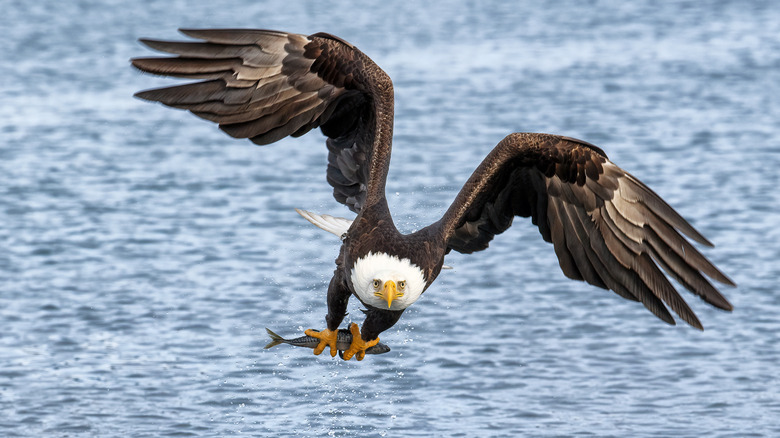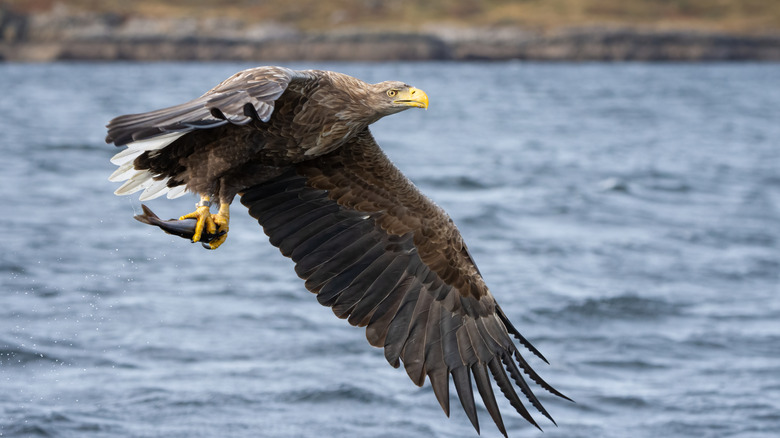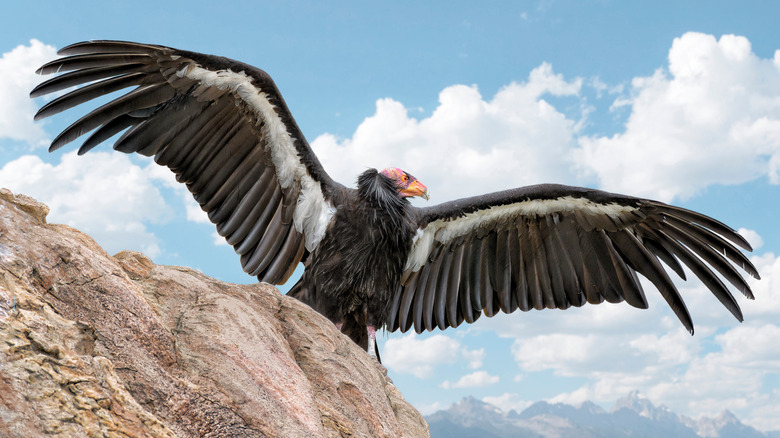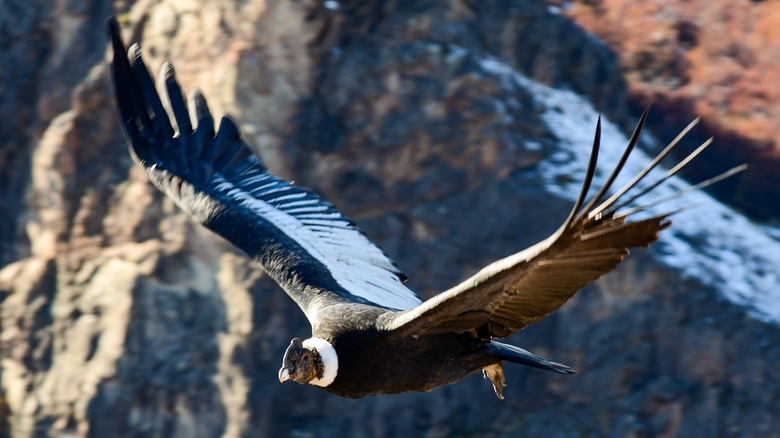The Biggest Birds Of Prey Still Alive With Wingspans That Will Make You Feel Small
Birds of prey, also known as raptors, consist of hawks, eagles, owls, vultures, condors, and falcons, which can be found in every corner of the world with the exception of Antarctica. There are over 560 species, with 35 found in the United States. These species range drastically in size from the smallest and cutest owl you will see, the elf owl, with a wingspan of just under 10 inches, to the Andean condor, which can have a wingspan of almost 12 feet across.
While no bird of prey stands taller than the average adult, the wingspan of the biggest raptors most certainly does. Wingspan, or the point from one wing tip to the other, is what makes these birds look so majestic. With so many different species of the proud hunter and its independent nature, only a world traveler will have the chance to see some of these large birds of prey. Those lucky enough to encounter any of these raptors will find that their impressive wingspans make humans feel small in comparison.
The American emblem, the bald eagle, has an impressive wingspan
The bald eagle (Haliaeetus leucocephalus) is a bird of prey every American will be familiar with since its induction as the national emblem in 1782. Seen as a symbol of strength and courage embodying the spirit of the American people, the bald eagle's connection was further cemented in 2024 when it was declared the national bird of the country. The image of strength can undoubtedly be attributed in part to its size, as the bald eagle boasts some impressive dimensions. Able to grow up to 2 feet tall, and weighing up to 14 pounds, the bald eagle's wingspan measures upwards of 7.5 feet; that's taller than Shaquille O'Neal at 7 foot 1 inch.
The bald eagle is native to North America, found in Canada, the United States, and Mexico. The best chance to see the national bird of the U.S. is in Alaska, along the east or west coasts, in the Rocky Mountains, or near the Mississippi River, where it can be seen year-round. Otherwise, residents in the U.S. might spot this majestic bird flying above during its migration. Bald eagles primarily feed on fish, but they also hunt smaller prey, and as scavengers, they will take advantage of opportunities to snatch another's meal.
People are likely to see these birds in flight at some point if they live in the U.S. due to their widespread presence and population. Overall, its population been steadily increasing. The bald eagle boasts approximately 316,700 individuals, including around 71,400 nesting pairs.
The white-tailed eagle soars across Europe and Asia on large wings
Heading across the pond, the white-tailed eagle (Haliaeetus albicilla) is the largest bird of prey in the United Kingdom. However, the raptor can be found far and wide across Europe and Eurasia. The animal is revered in many countries, including being chosen as the national symbol of Poland and appearing on the coat of arms in Germany.
Much like its American counterpart, the white-tailed eagle presents strength and elegance backed by a strong frame. Growing to a max length of around 3 feet, and weighing up to 15.2 pounds, the white-tailed eagle edges out the bald eagle with a wingspan that can reach almost 8 feet.
Thriving on fish, but also including a diet of smaller mammals as well as already deceased animals, the best place to see a white-tailed eagle is along coastal areas. While the massive bird covers a wide range, the healthiest populations appear in Russia and Norway. The white-tailed eagle population is estimated to be between 20,000 and 50,000; while not considered a threatened species, spotting one is still a matter of luck.
The rare Steller's sea eagle remains the largest bird of prey of its kind in the world
Despite its large size, the Steller's sea eagle (Haliaeetus pelagicus) is one of the least researched birds of prey due to its remote location and small population. The large raptor is found primarily along the coasts and rivers of northeastern Siberia, with some species remaining in the area year-round. However, some have been spotted migrating to the Kuril Islands and Hokkaido, Japan.
An encounter with a Steller's sea eagle is unforgettable; as the largest eagle in the world, its proportions are truly impressive. Steller's sea eagles can weigh up to 20 pounds and can reach a length of up to 3.3 feet. To support this large frame, the raptor has a wingspan of up to 8 feet 2 inches; equivalent to the height of "Sesame Street" star Big Bird.
Last assessed in 2021, the massive bird of prey is currently listed as vulnerable on the International Union for Conservation of Nature's Red List, with a population estimate between 3,600 and 4,670, and a continued decline in the population. However, a recent, unprecedented sighting in Canada at the beginning of 2025 suggests that people may still have the opportunity to encounter this one-of-a-kind bird of prey in the future.
The California condor is the largest land bird in the United States
California is known for its diverse wildlife, including the recent explosion of an animal species being called "Nature's Swiss Army Knife." Yet, one of the most remarkable creatures it is home to is the massive California condor (Gymnogyps californianus). Historically found in the U.S., from California to Florida, and along the coasts from western Canada to northern Mexico, the largest land bird in North America has faced conservation challenges over the decades.
The lowest recorded number of California condors was in the 1980s when they nearly faced extinction, with numbers as low as 22 known birds. They remain a rare sight, as their population is still considered critically endangered by the International Union for Conservation of Nature. Currently, there are only 275 condors found across California, Utah, and Arizona, with another 160 in captivity.
Spotting one is rare, but you may be able to see the bird feeding on carcasses as a carrion predator in one of the few states where it resides year-round. Its figure is instantly recognizable, standing as tall as 3.5 feet, weighing over 21 pounds, and boasting an intimidating wingspan of nearly 9.5 feet; this large bird could wrap its wings alongside a pool table with a few inches to spare.
The Andean condor has the largest wingspan of any raptor in the world
With a wingspan that makes other birds seem small by comparison, the Andean condor (Vultur gryphus) will make anyone feel tiny in comparison. The wingspan of the Andean condor ranges from 10 to 12 feet, which is necessary to support its large frame, weighing 20 to 30 pounds and standing 4 feet tall; this wingspan is equivalent to two California king mattresses pushed together.
The only way to see the largest bird of prey is to head to the Andes Mountains, as they are home to this species, which is distributed along the range from Venezuela to Tierra del Fuego in Argentina. As a carrion bird, the only time someone is likely to get a view of the Andean condor is when it is feeding on a carcass, since these birds live in the rocky mountain ranges in caves, ledges, or cavities to avoid predators. Getting a chance to see these remarkable birds is indeed a once-in-a-lifetime opportunity.
Want more articles on enormous animals? Read about how South America's largest mammal, thought extinct, was spotted in a protected zone.





